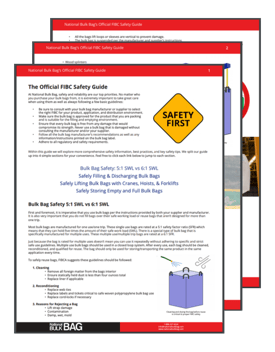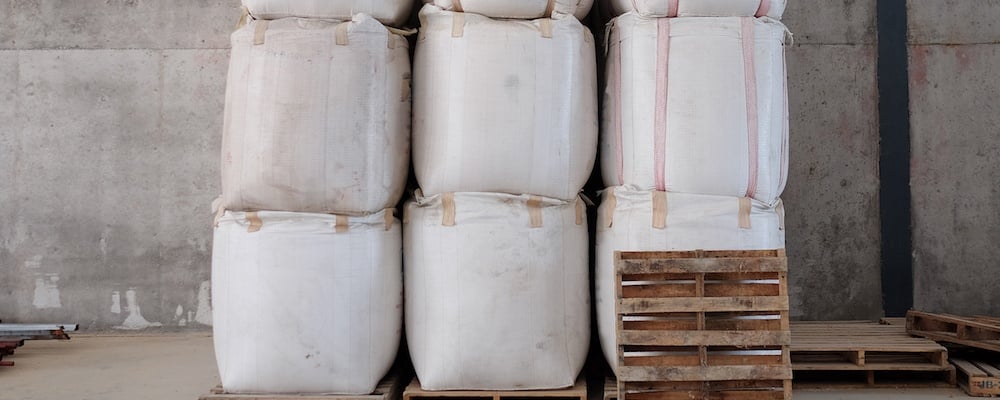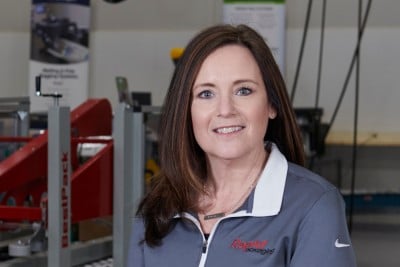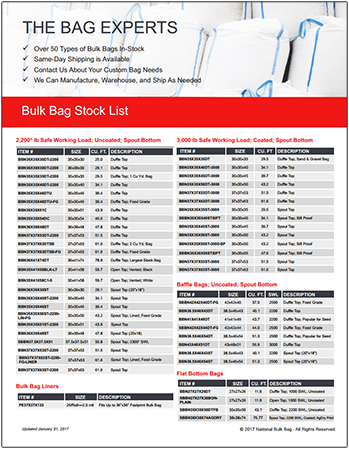Updated 4-5-2022
When using woven polypropylene bulk bags, it is important to use them per the instructions provided by both your supplier and the manufacturer. It is also important that you do not fill bags over their safe working load and/or reuse bags that aren’t designed for more than one use/trip. Most bags are manufactured for a single use bag but some are specifically designed for multiple uses.
What's the difference between 5:1 and 6:1 bulk bags? What type of bag is right for your application? Lets examine what safe working load means and the differences between 5:1 and 6:1 bags to determine what type of bag is right for your application.
For regular updates, subscribe to our blog by filling out the “Subscribe to our blog updates” form to the right.
What is Safe Working Load (SWL)?
When it comes to the safe handling of FIBC bulk bags, it's important to be aware of the correct Safe Working Load for your load capacity. This is the maximum load limit that can be safely carried by a bulk bag without risking damage or injury. A FIBC Bulk bag with a Safe Working Load of 5:1 are designed for a lighter load capacity, while those with a Safe Working Load of 6:1 can carry heavier loads.
It's crucial to ensure that the weight of the material being transported doesn't exceed the load limit of the bag, as this could result in damage to the fabric or seams, and could even lead to injuries. Always check the Safe Working Load of a bulk bag before use, and never overload a bag beyond its limit.
When transporting materials in a FIBC bulk bag, it's important to use the correct equipment and be aware of appropriate safety standards. Safe working practices and correct lifting techniques are essential when dealing with heavy loads. Failure to comply with safe working procedures can lead to serious injuries.
What is a 5:1 FIBC?
Most woven polypropylene bulk bags are manufactured for one use/one trip. These single use/single trip bags are rated at a 5:1 safety factor ratio (SFR) which means that they have the ability to hold five times the amount of their safe work load (SWL). Remember, although the bag is rated to hold five times the rated safe working load, doing so is unsafe and is not recommended.
Key Safety Tip: Never use a 5:1 safety ratio bag for more than ONE use/trip. 5:1 SFR bags are specifically manufactured for a single use/trip use. According to ISO 21898, using a 5:1 SFR bag is dangerous and can result in a unsafe working environment.
What is a 6:1 FIBC?
Some woven polypropylene bulk bags are specifically manufactured for multiple uses. These multiple use/multiple trip bags are rated at a 6:1 safety factor ratio, which means they have the ability to hold six times their rated safe working load. Just like 5:1 SFR bags, it is not recommended that you fill 6:1 SFR bag over its SWL as doing so can result in an unsafe working environment.
Just because the bag is rated for multiple uses doesn’t mean you can use it over and over again without adhering to specific safe use guidelines. Multiple use/trip bags should be used in a closed loop system. After every use, each bag should be cleaned, reconditioned, and qualified for reuse. The bag should also be used for storing/transporting the same product in the same application every time.
To safely reuse bags, FIBCA suggests these guidelines should be followed:
- Cleaning
- Remove all foreign matter from the bags interior.
- Ensure statically held dust is less than four ounces total.
- Replace liner if applicable.
- Reconditioning
- Replace web ties.
- Replace labels and tickets critical to safe woven polypropylene bulk bag use.
- Replace cord-locks if necessary.
- Reasons for rejecting a bag
- Lift strap damage.
- Contamination.
- Damp, wet, mold.
- Wood splinters.
- Printing is smeared, faded or otherwise unreadable.
- Tracking
- The manufacturer should maintain a record of origin, product used in the bag and the quantity of uses or turns.
- Testing
- Bags should be randomly selected for top lift testing. The frequency and quantity shall be determined by the manufacturer and/or user based on their specific situation.
Key safety tip: Not properly inspecting/testing multiple use bags is dangerous and can result in an unsafe working environment. Be sure to follow all of FIBCA’s safe reuse guidelines above and also found here (FIBCA’s safe reuse guidelines).
Which is right for your product and application?
Now that you know the difference between a Safe Working Load of 5:1 and 6:1, you can select the right bag for your application. Keep in mind, although using a bag multiple times has the potential to make your operation more environmentally friendly and cost effective, properly cleaning, reconditioning, inspecting, tracking and testing bags can be a time consuming activity that may reduce or ultimately cancel out the benefits of multi-use bags. It entirely depends on your specific operation and the resources you have at your disposal. In most circumstances, 5:1 SFR bulk bags are the best fit.
Thanks for reading!
 At National Bulk Bag, safety and reliability are our top priorities. No matter who you purchase your bulk bags from, it's extremely important to take great care when using them. Within this guide we explore comprehensive safety information, best practices, and key safety tips.
At National Bulk Bag, safety and reliability are our top priorities. No matter who you purchase your bulk bags from, it's extremely important to take great care when using them. Within this guide we explore comprehensive safety information, best practices, and key safety tips.
Our safety guide is split up into four sections for your convenience:
- Bulk bag safety: 5:1 SWL vs. 6:1 SWL
- Safely filling & discharging FIBCs
- Safely lifting FIBCs with cranes, hoists, & forklifts
- Safely storing empty and full FIBCs
Download our Official FIBC Bulk Bag Safety Guide by clicking the button below!






